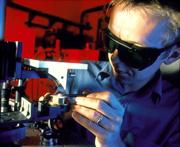 This terahertz imager is being used to probe the internal structure of a tooth.© SPL
This terahertz imager is being used to probe the internal structure of a tooth.© SPLAfter years of fiddling around with plastic ribbons and exotic fibres, physicists have found that a simple metal wire is all they need to pick up terahertz radiation. The discovery could speed the development of new medical and security imaging.
Terahertz waves, which nestle between microwaves and infrared light in the electromagnetic spectrum, are able to penetrate materials such as plastic and cardboard, which are opaque to other wavelengths. But technology using them has been slow to take off because it is difficult to guide the waves from one place to another.
Now it seems that a humble length of stainless steel wire is enough to carry the waves to a receiver, in the way that a coat-hanger jammed into a portable radio helps it to pick up a signal. Daniel Mittleman and Kanglin Wang at Rice University in Houston, Texas, reveal their waveguide in this week's Nature1.
"I was very surprised how well it worked and how simple it was," says physicist David Citrin at the Georgia Institute of Technology, Atlanta. "There may be people kicking themselves that they didn't think of this."
Lost in translation
Physicists have tried out a range of terahertz waveguides in the past, says Mittleman, but none of them has been particularly good. For example, hollow metal pipes can carry terahertz waves, but they absorb the radiation very quickly, turning it into heat. This means that most of the terahertz waves are lost in translation. Pipes also transmit waves of different frequencies at different speeds, making it impossible to reconstruct detailed information from a broad frequency scan. Mittleman's wire avoids both of these problems.
The latest discovery was a beautiful example of scientific serendipity, says Mittleman. The researchers were working on a new way of producing terahertz images that involved bringing a metal rod very close to a metal surface. When they pointed the terahertz waves at the metal rod, rather than the surface, they found that they could still pick up the radiation, but with a time delay as the wave travelled down the rod.
The new method is comparable to a radio aerial, in which electrons are sloshed from one end to the other as the long wavelength radio waves change the electromagnetic field in the wire. At shorter wavelength terahertz frequencies, the electrons only wobble by a few millimetres, but this creates areas of high and low electron density.
These areas of high and low density then travel down the wire, just like sound waves passing through air. When they hit the end of the wire, they regenerate electromagnetic terahertz waves that cross a short distance through air before being picked up by a receiver. This allows Mittleman and Wang to use wires to guide terahertz waves to wherever they want.
Wired up
To prove the point, Mittleman and Wang made an endoscope that can see inside confined spaces using just two wires and a metal plate. Terahertz waves travel down one wire, bounce off the angled plate and the interior of the container, and then travel back up the second wire. Amplifying this signal generates a crude image of the container's insides.
Once they can be manipulated more easily, terahertz waves could be used to see inside suspect packages at airports, Mittleman says. They will not replace X-rays, because they cannot penetrate metal boxes. But they can distinguish between different chemicals inside a package, each of which absorbs a characteristic set of terahertz frequencies.
A terahertz device similar to Mittleman and Wang's, for example, could be inserted through tiny holes in cargo containers to check for residues of explosives. Because the wire can carry a very broad range of different terahertz frequencies at once, it allows a general chemical analysis.
Georgia Institute of Technology, Atlanta
